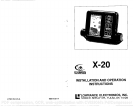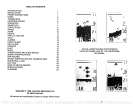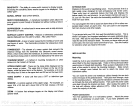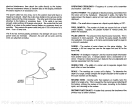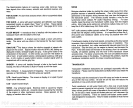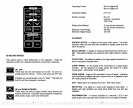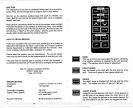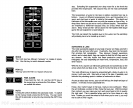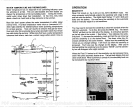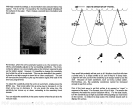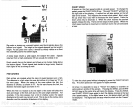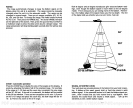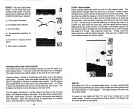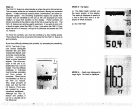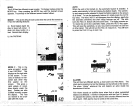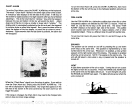
1
MODE
_______
The
X-20 has five different screens" or modes of
opera-
tion. Use this
key
to switch
between modes.
fl 1
FISH I.D.
•
j
This
key
turns the Fish l.D. feature off and on.
r 1
FISHALARM
I
•
1101
Press both the Fish ID. and the AUTO
key
at
L. IL.
the same time to activate the Fish Alarm. This is
an audible fish alarm.
AUTO
Turning
the unit on enables the automatic mode. To switch
to the manual
mode,
press
the AUTO
key.
You can return
the unit to automatic at
any
time
by pressing
the AUTO
key
again.
stay. Schooling
fish
suspended
over
deep
water lie at the level that
provides
this
temperature.
We assume
they
are the most comfortable
here.
The
temperature
of water in the lake is seldom constant from
top
to
bottom.
Layers
of different
temperatures
form,
and the
junction
of a
warm and cool
layer
of water is called a thermocline. The
depth
and
thickness of the thermocline can
vary
with the season or time of
day.
In
deep
lakes there
may
be two or more at different
depths.
Thermoclines
are
important
to fishermen because
they
are areas where fish are
active.
Many
times bait fish will be above the thermocline while
larger
game
fish will
suspend
in or
just
below it.
The X-20 can detect this invisible
layer
in the
water,
but the
sensitivity
will
probably
have to be turned
up
to see it.
SURVEYING
A LAKE
The most successful
anglers
on
any body
of water are those who fish it
day
after
day
and
year
after
year. Eventually, they
learn the hot
spots
that
produce
fish
consistently. They
discover
through experience
where,
and at what
depth, they
can
expect
to find the fish
they
want at
any
season. And
they
realize that these
productive
areas
change
throughout
the
year depending
on water
level,
temperature,
food,
and
other factors.
With the
X-20,
anyone
can eliminate
guesswork
and concentrate on the
areas where fish are
likely
to be. Even if it's the first time on the lake!
The most efficient
way
to become
acquainted
with a
body
of water is to
survey
it with
your
unit. Start with a
map
of the
lake,
if
possible,
and
indicate the
promising spots
in relation to landmarks on shore.
As
you go
about
your survey, your
unit
will tell
you
the
depth
and
type
of
bottom. It
will
also reveal
suspended
fish.
Keep
a few marker
buoys
in
the
boat, ready
to toss overboard. When
the unit indicates a school of
fish,
throw the
buoy
out. With the school
thus
marked,
you
can make
your
turn and come back to fish in
exactly
the
right spot.
This is essential when
you're
far from shore on a
big
lake. Unless
you
mark the school of fish when
you're
over
it,
you may
not be able to find it
again.
6
23
PDF compression, OCR, web-optimization with CVISION's PdfCompressor



